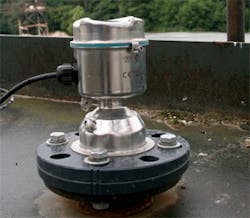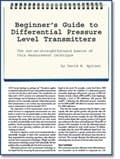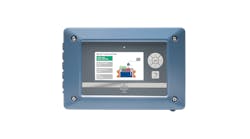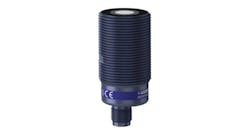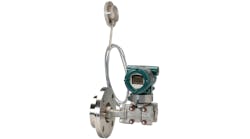Of course, most process materials have enough time to settle before they're measured, but users churning out increasingly complex products faster are pushing existing level devices to their limits. As a result, engineers, integrators and suppliers are helping users implement more sophisticated level technologies, combining existing level devices in new ways and also adding peripheral components and software that can help.
Guided by Radar
Two of the today's most popular and frequently compared level solutions are through-air/non-contact radar and guided-wave radar (GWR). The first sends electromagnetic microwave pulses through the atmosphere, while GWR directs its pulses along a probe or, increasingly, flexible cable. As usual, the trick is to have the right level technology to fit the application.
Figure 1: Sibelco UK's quarry uses flush-mounted, non-contacting Sitrans LR560 through-air radar level measurement transmitters from Siemens to avoid abrasive damage. They operate at a higher frequency of 78 GHz and use a narrower 4° beam angle to make sure their level measurements are accurate.
Siemens
"In the past, occasional unplanned shutdowns due to probe failures or coating issues would upset our process, reducing product throughput and increasing energy use," says Barry Schardt, Red Arrow's equipment manager and electrical engineer. "Since we installed Emerson's GWR transmitters a few years ago, we haven't had premature shutdowns during a production run due to level probe failure."
See Also: Beginner's Guide to Differential Pressure Level Transmitters
[javascriptSnippet]
GWR isn't affected by pressure and vapor-space changes, and SQM provides diagnostic information that relates directly to the coating on the probe and to changing surface conditions. These values can be assigned as process variables and tracked over time. This means Red Arrow's staff can use their SQM data to maintain ideal operating conditions and improve product quality over extended, continuous runs."We're seeing more acceptance of radar technologies as they mature, and GWR is growing faster than other level technologies," says Christoffer Widahl, senior product manager for new level programs at Emerson.
Fly Through the Air
As capable as GWR is in many applications, there are others where through-air/non-contact radar is indispensable for getting pulses through and securing accurate signals.
For example, Sibelco UK ships 750,000 to 800,000 tons of red and white silica sand per year from its 12-15-meter-deep quarry in Arclid, Cheshire, U.K. The white sand is used for making glass, and the red sand is used for playing-field drainage, animal bedding and other purposes. Once the sand is conveyed, cleaned, conditioned, graded and sorted, it's stored in 20- and 49-meter silos.
These silos previously used GWR, but the abrasive sand was hard on the contact devices, and forced technicians to adjust them often to get accurate level readings. As a result, Sibelco recently switched to Sitrans LR560 through-air radar level measurement transmitters from Siemens. Operating at a higher frequency of 78 GHz and using a narrower 4° beam angle, LR560 ensures that level measurements are consistently accurate. And, because the transmitters are flush-mounted and non-contacting, Sibelco's technicians don't need to worry about the abrasive sand affecting the instruments.
Figure 2: The coagulation tank at Aston Martin's paint shop uses a VegaPuls WL61 through-air radar sensor and its signal-focusing, 80-mm antenna to penetrate foam, secure millimeter level readings, maintain optimum water levels in the tank and prevent overflows.
Vega
Herman Coello, level market manager at Siemens, adds, "Ten or 12 years ago, you had to be an expert to set up a radar level transmitter, but today they're super simple and can be set up in a couple of minutes. To avoid overspills and fines, radar solutions can also be combined with secondary technologies such as mechanical floats, electronic capacitance devices or point-level switch for vessesls needing alerts and alarms."
Similarly, Aston Martin Lagonda Ltd. in Gaydon, Warwick, U.K., adds up to nine coats of paint to its auto bodies during a 50-hour process.
As a result, its paint shop must be carefully controlled. This includes its water recycling application and 3.5 x 5 x 8-meter coagulation tank with 140,000-liter/minute effluent flow, where entrained solids are removed (Figure 2). At the inlet, two transfer pumps force the incoming stream downwards, aerating the water to accelerate and improve the separation process. The coagulated solids settle at the bottom of the tank, and the clean, aerated water at the surface flows over a weir to be further treated and reused. The solids at the bottom are periodically pumped away for drying and disposal.
Because effluent treatment problems can quickly halt painting and production, Aston Martin's engineers report it's crucial to maintain optimum level and prevent overflow in the tank. However, this can be difficult because the water's surface is turbulent, it foams readily and heavily, and buildup on any contact device quickly causes problems. In fact, after installing a GWR and trying point level switches, they found the heavy, unpredictable buildup and contamination on the probes was so severe that they caused false readings and needed frequent cleaning.
Several process control and automation suppliers offer online resources for learning about, evaluating, comparing and selecting the appropriate level measurement technologies based on the specific needs of each application. Here are a few of the most useful:
- Endress+Hauser Applicator lets users input the temperature, pressure and other parameters they need, and narrow their selections to the most appropriate choices for level measurement and other technologies. It's located at https://portal.endress.com/webapp/applicator10.
- The Rosemount Library App from Emerson Process Management's Rosemount Tank Radar AB division provides a series of easy-to-use engineering guides, which offer comprehensive information in the selection and installation planning of process components, including level measurement devices. Visit the library.
- "A Dozen Ways to Measure Fluid Level" is a white paper by ABB K-Tek that compares many of the most popular fluid-level methods.
"The readings we now get are to the millimeter, which is extremely accurate, and allows us to have a greater level of control, especially as this measurement also governs the water make-up valve, which operates to re-level the tank as water evaporates due to the process," stated Aston Martin's engineers. "All of the control strategy for the coagulation tank water system was rewritten after installation due to the radar level sensor's greater level of accuracy, and so far we've enjoyed a 100% efficiency rate. The safety surrounding the tank has also been increased because we don't have to enter the guarded area around the tank to clean off buildup. Being non-contact is ideal in this application, so if the pit is cleared out, we don't risk any sensor damage either."
Jeff Brand, product manager at Vega Americas Inc., reports that it's improving performance of both through-air and GWR with more powerful, less costly microprocessors. "Better chips allow level measurement devices to send and receive more pulses quicker," says Brand. "Those rates have doubled over the past five years, so we have much better resolution and signal processing, and we're able to resolve levels faster and more accurately. The typical accuracy for our through-air products is ±1 mm where it used to be ±8 mm, and this means better inventory control and decision making for users."
Beyond radar, some developers and users are implementing sonic scanners and laser-based devices to map material surfaces in vessels and help calculate their volumes and contents. For instance, Anglo Gold Ashanti's (AGA) Moab Khotsong mine contributes 16.4% of the gold ore used by AGA's South African operations. The ore is stored in 10 x 22-meter silos that can hold up to 10,000 tons, but grizzly bars across an aperture at the bottom of the silos must always be covered by enough material to avoid damage or blockages caused by rocks and gravel entering the silos.
As a result, AGA recently adopted Rosemount 5708 3D acoustic solids scanners in its gold ore silos to provide reliable content volume measurements. The resulting 3D graphical output of the mapped surface allows AGA's site operations team to monitor if there's sufficient gold ore for production and make sure it's spread out enough to cover and protect the grizzly bars. They also enable the team to see from a safe location if bridging or buildup is happening inside the silo.
"The 3D solids scanner provides us with accurate measurements in our large silo, which allows us to protect our equipment," says Ernst Smith, C&I manager at AGA.
Similarly, ABB K-Tek recently released its VM3D volumetric measurement, 3D laser scanner that can form 3D maps of stockpiled solids in vessels. "Uses can use VM3D to laser-trace profiles of chemical, fertilizers, coal, potash and other materials to more accurately determine their inventories," says Charles Richard, ABB K-Tek's global products manager for radar and magnetostrictive products.
Multitasking Measurement
Though level methods haven't changed much at their roots in recent years, they have been combining technologies for better measurement, joining with microprocessors and software that make sensors and level transmitters smarter and more capable, and using networking and data management tools that help users make better decisions based on their analyses.
Gene Henry, senior product manager for level at Endress+Hauser, reports that E+H launched its Levelflex FMP55 multiparameter device a couple of years ago to combine guided radar and capacitance in one component. This cooperation is useful in level applications with an emulsion layer, and it's even more helpful when there isn't a clear separation between these layers.
"With a rag layer like this, the overall radar signal can get lost sometimes, and when this happens, our FMP55 can automatically switch to capacitance," explains Henry. "Basically, the FMP55 provides two outputs. One is the overall guided radar, while the other can interface with capacitance or guided radar. Many products are separated by density, but now users no longer need to have two devices."
Richard adds that ABB K-Tek's Magwave solution combines magnetostrictive, GWR and local float components in one device with one set of process connections, and can add magnetically actuated switches to the float. "This is a dual-chamber device," says Richard. "The GWR measures liquid and produces a 4-20 mA signal; the magnetostrictive device detects the bullet float inside and has a 4-20 mA output; and the float and magnetic gauge have a local indicator. Having two independent and redundant transmitters and a local indicator is getting popular because they're safer."
Henry agrees that more powerful, less costly microprocessors, software and algorithms are enhancing level measurement capabilities and coordination. "The real innovations in level today are on the software side because we can use more of the data we're getting from the same instrumentation," says Henry. "So if we've got foam, and we're monitoring the signal strength of free-air radar coming through it, we can now evaluate that signal with software, quantify how much foam is developing based on how much the output signal strength is diminished, and decide when and how much defoamer to add. Previously, defoamer was added periodically, which meant too much was used at too much cost.


